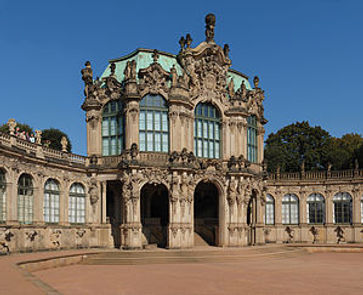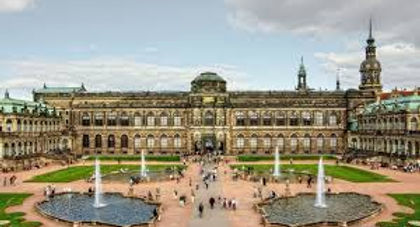74.
Renaissance into Baroque: *


Michelangelo’s David (1501-04) is a heroic male nude, his face reflects deep serenity, stillness just before confronting great danger; the pose is contrapposto (a tribute to the Classical sculptors), strictly frontal, dictating a view from the front.
Bernini, the most accomplished Baroque sculptor, also produced a David. Bernini’s David is angry, frowning and biting his lower lip, his face contorted in aggression. The figure is twisted & it challenges the viewer to walk around it to contemplate its changing nature. Bernini allows his David to project into the viewer’s space, as he literally oversteps the boundaries, putting his toes over the edge of the plinth.
Renaissance painters created a 3D space for their viewers, including: linear perspective, vanishing points, foreshortening, and atmospheric perspective & distance in the background. They painted naturalistic realism in faces, calm placid & strong expressions reflecting a belief in the nobility of man. Compositions were symmetrical & balanced, the main figure in the center & subsidiary figures arranged on either sides. Consistent lighting was used along with a wide range of colors, and chiaroscuro (extreme of light and dark). Baroque painters retained linear perspective but used it differently; in some cases (Caravaggio) the subject protrudes into the viewer’s space in the foreground. Serenity is replaced by dramatic & intense emotion. Renaissance art depicts the moment before an event, Baroque artists chose the dramatic moment when the action was occurring. It uses great drama, rich, deep color, and intense light & dark shadows.
The Last Supper (1497) by Leonardo; the work is symmetrical & balanced; Christ is the centre of the painting; a stable, calm triangular form (in contrast with the agitated activity of the disciples); his head framed by the natural light of the middle of the 3 windows behind him & linear perspective places a vanishing point directly behind his head.
Contrast this with Tintoretto’s last Supper (1592). Christ is still the focal point, with the largest brightest halo but viewed from the side. There is a dynamic drama, the table placed at an angle pointing off-centre deep into space. The darkness & lighting and the theatrical gestures of the characters create heightened emotions. Amidst the human activity we see the heavens opening & ghost like angels descending to witness the scene.


Renaissance architecture emphasized symmetry, proportion, geometry & regularity of parts, as demonstrated in classical Roman architecture. We see the orderly arrangements of columns, pilasters and lintels, as well as the use of semi-circular arches, hemispherical domes & niches replacing the complex lines, proportional systems & irregular profiles of medieval buildings. Contrasting this is Baroque's use of lavish decorations. Renaissance design forced form to follow function; with the Baroque architecture was seen as theater, emphasizing effects, interpretations & movement. The design elements became more emotional & dynamic, focused on energy against balance. It also controlled the viewing platform, as exemplified in Bernini's piazza at St Peters Rome, framed by a colonnade formed by a doubled pairs of column, the arms of the Church!
Palladio’s Villa Capra (1567-1620) was inspired by the Pantheon in Rome; it reflects balance, symmetry & simple lines. It is completely symmetrical with a square floor plan, 4 facades, each having projecting portico. Each portico has steps leading up to it & opens via a small corridor to the circular domed central hall.

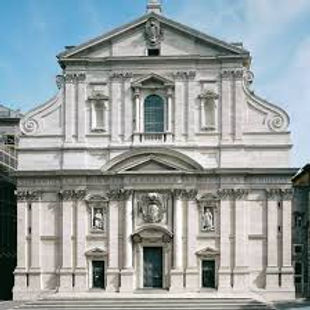
The Church of the Gesù (Rome, 1568-84) first baroque façade; designed by Vignola & Della Porta. Reflects dynamically fused tension bound by strong vertical elements. The façade is divided into 2 sections; the lower section is divided up by 6 pairs of pilasters with Corinthian capitals, the upper section divided with 4 pairs of pilasters; a volute joins them. The main door stands under a curvilinear tympanum, 2 side doors are under a triangular tympanum. Decorations include a Christogram, a papal coat of arms & a shield.
75.
Michelangelo (and early Baroque): *
Michelangelo’s contribution was the ovoid dome, a modification which provides visual tension & compression. The ovoid shape (rather than the hemispherical) moves away from the Classicism of the Renaissance, and prefigures the architecture of the Baroque.

76.
Romano-Florentine colonnading & storying: *
Palazzo Medici (1444-84, Rome) by Bartolomeo for Cosimo de' Medici; uses tripartite elevation expressing rationality, order & classicism, the tripartite division emphasized by horizontal stringcourses dividing the building into stories of decreasing height while transition from ground floor rusticated masonry to the delicately refined stonework of the 3rd floor the makes the building seem lighter & taller.
Hospital of the Innocents (Florence, 1419) Brunelleschi, early Italian Renaissance; the building has a clean and clear sense of proportion; height of the columns is the same as the width of the intercolumniation & the width of the arcade, making each bay a cube; the height of the entablature is half the column height. These simple proportions reflect a new age of secular education, a sense of great order & clarity.


77.
Mature Baroque: *
Bernini represent the culmination of the Mature Barque. His work was theatrical, and his best is seen in massive programmes of cross disciplines (architecture, sculpture, decorative). The next generation of artists began moving away from the grand dynastic & religious statements of the High Baroque, towards subjects less politically pointed. This movement was also French as against the Italian roots of Baroque. It usually covers the kind of ornament, style and design associated with Louis XV's reign and the beginning of Louis XVI - art from around the middle of the 18th century in France. It is also notable for moving away from the Baroque princes & lords, towards more middle class patronage and themes.
Bernini, Ecstasy of Saint Teresa (1647-52), Santa Maria della Vittoria, Rome
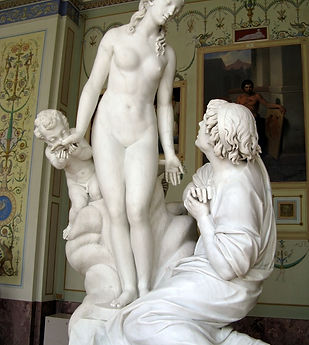
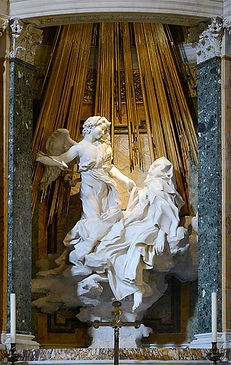
Falconet's Pygmalion and Galatee (1763) reflects the Rococo style in its depiction of lighthearted love, including a cherub indicating its predisposition to mythology.
painting:
Antoine Watteau, Pilgrimage on the Isle of Cythera (1717, Louvre) captures the frivolity and sensuousness of Rococo painting.

architecture:
widely found in Germany, Austria, and Central Europe. One of the best examples is the Basilica of the Fourteen Holy Helpers (1743-72)
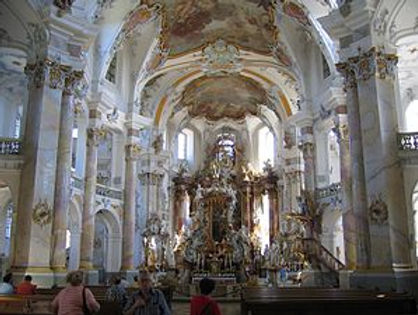
music:
The giant of course was JS Bach.
His Oratorio St Matthew Passion is a prime example of late baroque music (1727)
78.
Rococo of Dresden. Paris and Vienna: *
Dresden has a long history as the capital and royal residence for the Electors & Kings of Saxony, who for centuries furnished the city with cultural and artistic splendour; the city was known as the Jewel Box, because of its baroque and rococo city centre.
Dresden Royal Palace: After a major fire in 1701, Augustus II the Strong rebuilt much of the castle in the Baroque style. The collection rooms were created at this time in the western wing. The Silver Room, Heraldic Room and the Pretiosensaal were built from 1723–1726
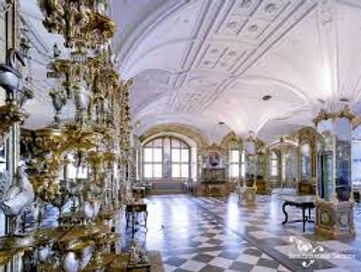
Paris can boast of many Rococo buildings. One of the best was the Hotel de Soubise although the Versailles Palace also was re-modelled on Rococo lines.
The Hôtel de Soubise, Paris was designed by Germain Boffrand (1667-1754),a French architect & one of the main creators of the precursor to Rococo (style Régence) while his interiors, are pure Rococo. This hotel was one of his major commissions (1735-40).
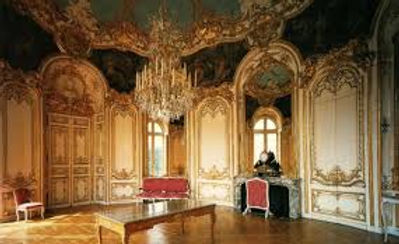
One of the finest palaces in Vienna, the Schönbrunn Palace is a massive 1,441-room Baroque palace. It is one of the most important architectural, cultural, and historical monuments in the country. It was built and remodelled during the 1740–50s during the reign of empress Maria Theresa who received the estate as a wedding gift. Franz I commissioned the redecoration of the palace exterior in the neoclassical style.
The tall windows and the crystal mirrors facing them on the opposite wall together with the white-and-gold stucco decoration and the ceiling frescos combine to form a total work of art in its own right, resulting in one of the most magnificent Rococo ceremonial halls in existence.
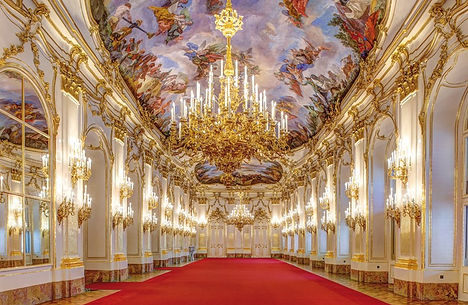
79.
Dresden Zwinger: *
notable for its extraordinary variety and magnificence of form: the majestic 32-bayed Long Gallery on the south side, the four symmetrically arranged pavilions on the east and west sides, the Wallpavillon, and the Nymphenbad (Bath of the Nymphs) with its graceful fountains and mythological female figures.
